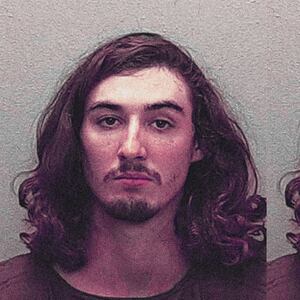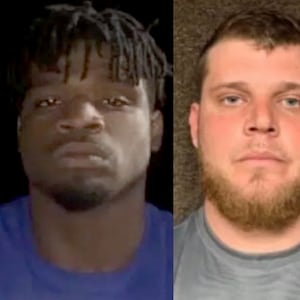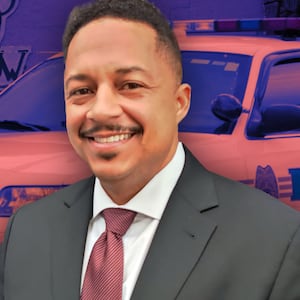Anthony Childs was walking down the street in Shreveport, Louisiana, one afternoon in February 2019 when he was spotted.
Dashcam video from that day, first obtained by the Shreveport Times, shows Shreveport Police Department officer Treveion Brooks hook a U-turn and drive up to Childs, who jets into an open field. The paper reported that Brooks was attempting to stop Childs, a 31-year-old Black man, because his shorts were sagging below his waistline, breaking a city ordinance that has since been repealed.
In the video, Brooks hops the curb and speeds toward Childs, nearly hitting him. Brooks, who is Black, gets out and is partly visible on the video taking cover behind his car’s trunk. It soon becomes clear that he believes Childs to be armed.

Anthony Childs
Courtesy Tauren Parker“Put the gun down,” he yells three times before two initial gunshots erupt. After a brief pause, three more shots are fired. More than 10 seconds pass, a period during which Brooks calls in the shooting. Then he says, “Hey, show me your hands,” and four more shots are fired.
When the smoke cleared, Childs lay dead. Of the nine shots fired, eight came from Brooks’ gun and three hit Childs, Caddo Parish District Attorney James Stewart later said in a statement. But Stewart argued the shots were “fired at a distant range” and were “nonlethal.”
The kill shot, he said, was a self-inflicted wound to the chest. Even that explanation was not easy to come by, according to Tauren Parker, Childs’ sister.
Parker told The Daily Beast that immediately after her brother’s death, it took about a month to get information from police about what happened. During that time, she met with community activists and spoke with other families who’d also had loved ones injured or killed by police and noticed what many in the area describe as a remarkable lack of transparency and accountability within the Shreveport Police Department.
In April 2019, Childs’ death was deemed a suicide, a ruling Parker said her family never believed. She said they’re convinced the truth was buried. “It’s hard when you’ve lost a loved one and you’re trying to figure out what is happening,” she told The Daily Beast. “And then the people that said they are going to investigate and find out tell you nothing.”
Skepticism about the 500-member police department in the majority-Black city of 188,000 hugging the borders of Texas and Arkansas isn’t unfounded. According to other community leaders and residents who spoke to The Daily Beast, as well as a review of lawsuits filed against local police, the department has been slow to release any information at all about deaths in custody and excessive use of force—particularly against members of the Black community. When it has, details have been scant.
<p><i><strong><em>Do you know something we should about police brutality or justice issues? Email Andrew.Boryga@TheDailyBeast.com or reach out securely via Signal at 978-464-1291.</i></strong></em></p>
The department has also failed to discipline officers until community outrage mounts over events, while declining to actively seek outside investigations for sensitive cases—opting instead to police themselves. In Officer Brooks’ case, he remained on the job until June 2020, when he was indicted by local prosecutors over another violent incident.
Experts say Shreveport’s police department has all the trademarks of a troubled agency in need of outside intervention. And now that the smoke has begun to clear from the hands-off policies of the Trump-era Justice Department—and a president who explicitly joked about police brutality—locals are wondering when the Biden administration might come to the rescue.
“They don’t hold their own accountable,” said Breka Peoples, a community organizer who has worked with many families of victims of police violence in Shreveport. “They need to be investigated.”
In a statement to The Daily Beast, Shreveport Police Department Chief of Police Ben Raymond admitted to a “strained relationship” between police and “some” members of the Black community in the city. He declined to speak directly about any indictments against officers, citing pending litigation.
Between 2019 and 2020, five incidents of alleged beatings and tasings by the department—including one that killed a man—resulted in charges for 16 officers in his department. LeVette Fuller, a city councilwoman in Shreveport, told The Daily Beast the charges amounted to a small victory, and it is remarkable that at least some cops are being charged by local prosecutors.

Tommie Dale McGlothen Jr.
Courtesy James CarterBut mostly she’s holding out for the larger, more pervasive reforms she believes the department—and city—desperately need.
“We need a complete audit,” she said. “This is not just a matter of indicting these officers. For them to be in these positions is a matter of supervision, training. They can’t be completely culpable without looking at the culture of the police department.”
In July 2020, Fuller submitted a formal request for a patterns or practice investigation to the Department of Justice after the City Council unanimously approved a resolution to do so. These investigations of police departments are meant to address widespread issues and push departments to change policies, training, hiring, internal affairs procedures, and the way they collect and report data.
Fuller hoped the documented cases of excessive use of force by the police department, as well as other evidence of them withholding information about those events in many instances, would be enough to get the DOJ’s attention for such an investigation in Shreveport. Raymond, for his part, said he would be open to it. “I welcome any external agency to investigate the Shreveport Police Department,” he told The Daily Beast.
According to Fuller, however, the Trump-era DOJ was silent. And so far, at least, that hasn’t changed under Attorney General Merrick Garland, she said. “There has been no follow up, for whatever reason,” she said.
The Department of Justice did not respond to a request for comment for this story.
Fuller speculated it could be because of a lack of local notoriety compared to the deaths of George Floyd and Breonna Taylor, which gained international attention and were followed by the Biden DOJ opening investigations into the Minneapolis and Louisville police departments. But she also believes the timing of her city’s plea—during the waning days of the Trump administration—didn’t help.
The Obama administration rolled out at least 25 investigations into police departments, according to Jonathan Smith, former chief of special litigation for the civil rights division of the DOJ from 2010 to 2015. But under Trump, Smith said, the DOJ severely scaled back and tried to put short time-limits on the agreements for reforms they made with police departments.
“It was a very, very sharp turn in the opposite direction,” Smith told the Daily Beast. “You essentially saw the leadership of the department attempt to abandon this work.”
Abandoned is how Fuller felt as the months have passed in Shreveport and more indictments have rained down on police officers—including, it should be noted, a federal indictment last month of an officer who allegedly tased, punched, and pistol-whipped an arrested man “without justification.”
Fuller said that under President Biden’s administration, she was hopeful for more than prosecuting so-called bad apples. Instead, she said, Shreveport needs wholesale reform.
“I hope we’re on that list,” she said. “I hope there is enough of a record there.”
Beyond allegations of vicious attacks on men and women of color, some of them already in custody, critics in Shreveport often emphasize the shroud of mystery under which investigations are handled, and in some cases seemingly kept quiet.
One of the more high-profile examples: the death of 44-year-old Black man Tommie McGlothen Jr. in April 2020.
The police were called about McGlothen three times before he died. The first time, James Carter, the family attorney told The Daily Beast, McGlothen’s family called the Shreveport Police themselves to report another “episode.” (In the past, he said, the family had sought help from cops for McGlothen, who suffered from paranoid schizophrenia and depression.) The second time, Carter said, McGlothen had gone missing from his home. The final time was after McGlothen allegedly got into an altercation with another man, according to The Shreveport Times.
After police arrived and arrested him, McGlothen was transferred to a local hospital and died early in the morning on April 6, 2020. It wasn’t until shaky cellphone footage was released two months later that it was revealed McGlothen was punched in the head and face, kicked, tased, and struck with a baton by four officers during a struggle on the ground and while getting into a patrol car.
Little was initially revealed by the Shreveport Police Department to the family about the circumstances of McGlothen’s death, according to Carter. Peoples said she spoke to McGlothen’s son shortly after, who felt something wasn’t right. She encouraged him to fight for answers. Given her experience, she said, it is the only way to get some semblance of the truth in Shreveport.
“If the family doesn't fight for it, it’s going to be swept under a rug,” she told The Daily Beast.
After pressure from the local community and McGlothen’s family intensified, Caddo Parish District Attorney Stewart released a statement on June 2, 2020, saying his office had only received investigative files from the Shreveport Police Department four days earlier. That is, 54 days after McGlothen’s death.
After reviewing the files, prosecutors said, there were “missing reports, statements, downloads, and other vital information that is essential to conduct a thorough and complete review,” and they asked for anyone with video evidence to come forward. Chief Raymond told The Daily Beast that the district attorney’s statements about the lack of files related to the death of McGlothen were “taken out of context” and that the office was “provided with all of the information our detectives had access to at the time.”
Peoples said she helped the family find the cellphone footage of McGlothen’s last encounter with police and share it with KSLA News 12, a local television station. Shortly after the video was released, Police Chief Raymond announced the four officers involved would be placed on leave, the station reported.
Raymond told The Daily Beast that McGlothen’s death was “immediately reported” to his boss, the mayor of Shreveport, Adrian Perkins. He said he did not intentionally withhold the information from the city council because he does not report to them. He said investigations like that of the death of McGlothen are “sensitive,” and the district attorney’s office has previously asked them not to release details about ongoing investigations because they may “harm the [district attorney’s] ability to prosecute the case, find neutral jurors, etc.” He defended his transparency and said he shares more information than his predecessors.
Perkins told The Daily Beast he was “made aware of an incident” by Raymond, “but with the information provided at the time, it was not immediately determined that it was an in-custody death, nor that it was Tommie McGlothen.” He said the investigation was ongoing and “we want to allow it to run its course,” declining to comment further.
The DA’s office did not respond to a request for comment.
In September 2020, the district attorney announced a grand jury had charged officers Treona McCarter, Brian Ross, D’Marea Johnson, and James LeClare with negligent homicide and malfeasance in connection with McGlothen’s death. DA Stewart said McGlothen had “a known medical condition” and that the Caddo Parish Coroner Dr. Todd Thoma believed his death was “preventable.” After the alleged beating of McGlothen, Stewart said, he was left by officers for 48 minutes in the back of the squad car without medical treatment.
According to Stewart, a review by a forensic pathologist confirmed Dr. Thoma’s finding that McGlothen died from excited delirium–a controversial diagnosis that describes extreme agitation and that critics say is used to obscure police violence. But the forensic pathologist also said the combination of the physical force and the delay in medical attention caused McGlothen’s death.
The alleged blackout of information was no one-off thing, Councilwoman Fuller said. She pointed to a separate beating of two Black men by police in January 2020 that was only revealed to the public five months later.
According to the District Attorney’s Office, Shreveport Police officers tried to stop Chico Bell, 40, and Damon Robinson, 44, for seatbelt violations as they left a home in a car. After hitting their light and sirens, Bell and Robinson allegedly continued to drive, and a pursuit began. Eventually, a Caddo Parish Sheriff deputy joined the pursuit.
When the car with Bell and Robinson came to a stop, the deputies’ dashcam shows Bell and Robinson raise their hands and stick them out the window, according to prosecutors. But Shreveport Police officers pulled Bell out of the car through the window, and punched, kicked and tased him, Stewart said. Medical records show he suffered a broken orbital plate. Prosecutors concluded that the same footage caught another Shreveport officer punching Robinson multiple times through the car window while his hands were held by other officers. He was taken to the ground and hit in the face with a flashlight while his hands were behind his back, shattering his nose, Stewart said.
Small amounts of ecstasy, cocaine, and a stolen gun that the two men had allegedly dumped out the window during the chase were later found along the route, Stewart said. But all charges against them were dropped due to the excessive force used in their arrest. Stewart said the Caddo deputy’s body camera and dashcam confirmed they “offered no resistance.”
On June 29, 2020, eight Shreveport police officers were indicted and charged with malfeasance in office over the incident, charges that carry a maximum sentence of five years if convicted. Among them: Treveion Brooks—the same cop who shot Childs.
Stewart said the Shreveport Police Department turned over records related to the January 2020 stop early that March, and the investigation was paused because of COVID-19. But Fuller said no one in the community found out about the vicious beating until the charges were revealed. A review of local media reports would appear to confirm that. The Shreveport Police Department declined to comment on pending litigation.
After getting the official narrative from police about the death of her brother, Anthony Childs, Parker, his sister, said gaps were never filled in. Among them: why there wasn’t any body camera footage from Brooks, or why her brother’s hands were never tested for gun residue even though he allegedly shot himself. The Shreveport Police Department did not respond to questions about whether Brooks was wearing a body camera that day; a 2020 report by a local ABC affiliate indicated 69 local cops were using body cameras in a force of some 500.
Dr. Todd Thoma, the Caddo Parish coroner, told The Daily Beast the gunshot residue test was never done because it didn’t seem necessary given the evidence they had. He cited video and audio evidence of the shooting, as well as an autopsy indicating the fatal shot that killed Childs was in the chest from a range of less than a foot. “The officer never got within 15 to 20 feet of Mr. Childs the entire time,” he said.
Parker said she doesn’t understand why the test wouldn’t have been done just to provide some finality. “I don’t think they investigated it like they should have investigated it,” she said.
Like other critics, she called on outside agencies to investigate shooting incidents, which is often standard in police departments around the country. “To get someone on the outside to come in, it would help. There are too many incidents that are happening here in Shreveport and nothing is getting done and they are investigating themselves,” she told The Daily Beast.
When asked about the prospect of outside agencies investigating alleged incidents of excessive use of force, Chief Raymond told The Daily Beast that he reached out to “outside agencies in many instances.”
But a spokesperson for the Louisiana State Police, the agency that could be charged with looking into such incidents, told The Daily Beast they only conduct investigations at the request of another law-enforcement agency. And they had no record of any requests from the Shreveport Police Department in the past five years, the spokesperson initially said.
In a follow-up statement, Chief Raymond told The Daily Beast he’d entered into an agreement with the Louisiana State Police in the last three months in which they would investigate all officer-involved shootings that result in death. He said the State Police would also be notified if someone were shot or injured, and that the department would attempt to have a State Police investigator respond to the scene.
The Louisiana State Police subsequently told The Daily Beast that they would investigate officer-involved shootings that result in death and in-custody deaths “at the request” of the Shreveport Police Department.
Smith, the former DOJ staffer under Obama, said a key component of the way investigations were run during his time there was to listen to community members like Parker and her family. In addition to collecting tens of thousands of reports and interviewing hundreds of members of a police department, he said, their investigations also sought to learn what policing looked like to people who lived in the community. “We try to understand how policing is actually experienced and to marry that up against the information we’re seeing in the records of the police department,” he said.
He added that in the case of Shreveport, an investigation would be jump-started by substantial evidence of a pattern of excessive force because of the indictment of so many officers in such a short time span. “What is going on there?” Smith asked.
An investigation would address whether there are hiring failures in the department, lack of training, lack of accountability when officers engage in misconduct, a cultural problem, or all of those things rolled into one—which he said is often the case.
Smith said the court-ordered agreements, or consent decrees, that police departments historically submitted to after a federal investigation aim to address these issues through policy changes, training, revamping internal affairs systems and collecting and providing more transparent data. The goal, he said, was to create a new culture in the department that lasts, which he said can take a decade in many cases.
While it all sounds good, Smith cautioned that DOJ investigations are not magic wands and don’t set out to “reimagine” policing—a popular demand these days. Defunding the police this is not.
”It’s not going to help people change the way that a community addresses public safety in a broader way,” he said.
But according to Peoples, the community organizer in the city, that isn’t the goal right now. Her mother is a police officer within the Shreveport Police Department and has been for 23 years, she said. “We have good police officers,” Peoples told The Daily Beast. “I’ve seen how they’re supposed to be, and how they’re supposed to carry themselves.” She said she also sympathizes with the fact that the department works in a high-crime area and is one of the lowest paid departments around.
But she said that recent incidents and the current leadership of the department has caused the community to lose trust in cops and their ability to hold themselves accountable. “If they don’t have respect for the community, the community is not going to have respect for the police,” she said.
Fuller, whose father was a longtime Shreveport police officer, agreed. She said her criticisms of the department are often overlooked because she is a city councilwoman with a background in library science and theater. “What does she know?” she said people often ask.
“OK, fine,” she said. “Then bring in a subject-matter expert. That’s what we’re asking for. And I don’t know how many more situations like these need to happen before someone decides we do need to look at the entire culture.”
“It’s not just one person,” Fuller added. “It’s not just the chief, it’s not just the mayor who selects the chief—there is something else going on within the culture of this department.”




